Download PDF
Download page Energy Budget Snow Validation and Verification.
Energy Budget Snow Validation and Verification
Introduction
This section documents the validation and verification (V&V) effort for the Energy Budget Snow method which was added within HEC-HMS v4.11. This new method is based on the Utah Energy Budget (UEB) snow model developed at Utah State University (Tarboton et al, 1995). The UEB snow model was originally developed using FORTRAN, which required conversion to Java for use within HEC-HMS. The HEC-HMS Java implementation was evaluated using data from the Earth System Model - Snow Model Intercomparison Project (ESM-SnowMIP). ESM-SnowMIP provides boundary conditions and observations at numerous locations throughout the world (Menard et al, 2019). These data sets were used to validate and verify the Energy Budget snow method computations within HEC-HMS.
Goals
The goals of the Energy Budget Snow V&V effort were:
- Make model calculations consistent between the FORTRAN (UEB Model) and Java (HEC-HMS) implementations,
- Refactor HEC-HMS code for improved readability and consistency with HEC-HMS coding standards,
- Ensure energy and mass conservation, and
- Develop automated tests that will flag altered results when future modifications are made to the HEC-HMS Energy Budget snow method.
Locations
In situ meteorological forcing and evaluation data, and bias-corrected reanalysis forcing data was available for ten locations: one maritime (Sapporo, Japan), one arctic (Sodankylä, Finland), three boreal (Old Aspen, Old Jack Pine and Old Black Spruce, Saskatchewan, Canada) and five mid-latitude alpine (Col de Porte, France; Reynolds Mountain East, Idaho, USA; Senator Beck and Swamp Angel, Colorado, USA; Weissfluhjoch, Switzerland) (Menard et al, 2019). A summary of these locations is shown below.
Site | Abbreviation | Latitude | Longitude | Elevation (m) | Vegetation | Soil | Snow-Free Albedo | Temperature Measurement Height (m) | Wind Measurement Height (m) | Data Availability |
|---|---|---|---|---|---|---|---|---|---|---|
| BERM Old Aspen | oas | 53.63 | -106.2 | 600 | 21 m high forest with winter SAI 1 | sandy clay loam | 0.14 | 37 | 38 | 01Oct1997 - 30Sep2010 |
| BERM Old Black Spruce | obs | 53.99 | -105.12 | 629 | 11 m high forest with LAI 3.5 - 3.8 | sandy loam | 0.08 | 25 | 26 | 01Oct1997 - 30Sep2010 |
| BERM Old Jack Pine | ojp | 53.92 | -104.69 | 579 | 13 m high forest with LAI 2.5 - 2.6 | sand | 0.11 | 28 | 29 | 01Oct1997 - 30Sep2010 |
| Col De Porte | cdp | 45.3 | 5.77 | 1325 | short grass | sandy clay loam | 0.2 | 1.5 | 10 | 01Oct1994 - 30Sep2014 |
| Reynolds Mountain East | rme | 43.19 | -116.78 | 2060 | short grass | silty clay | 0.2 | 3 | 3 | 01Oct1988 - 30Sep2008 |
| Sapporo | sap | 43.08 | 141.34 | 15 | short grass | clay | 0.2 | 1.5 | 1.5 | 01Oct2005 - 30Sep2015 |
| Senator Beck | snb | 37.91 | -107.73 | 3714 | alpine tundra | thin soil and exposed bedrock | 0.2 | 3.8 | 4 | 01Oct2005 - 30Sep2015 |
| Sodankylä | sod | 67.37 | 26.63 | 179 | short grass | sandy loam | 0.2 | 2 | 2 | 01Oct2007 - 30Sep2014 |
| Swamp Angel | swa | 37.91 | -107.71 | 3371 | short grass | colluvium | 0.2 | 3.4 | 3.8 | 01Oct2005 - 30Sep2015 |
| Weissfluhjoch | wfj | 46.83 | 9.81 | 2540 | barren | moraine | 0.1 | 4.5 | 5.5 | 01Sep1996 - 30Sep2016 |
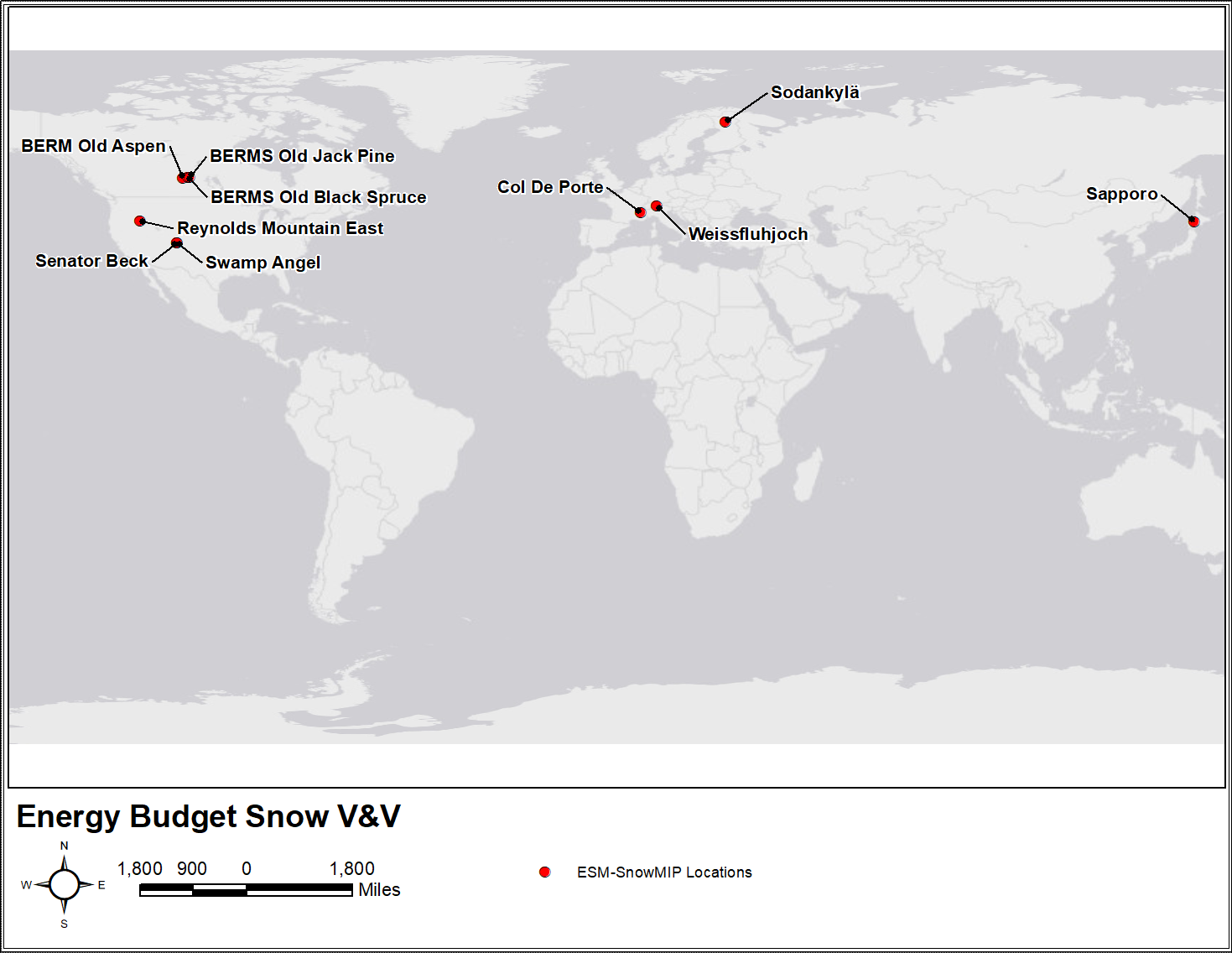
Approach
An HEC-HMS project was constructed for each of the aforementioned ESM-SnowMIP locations. Basin and meteorologic models were created to represent the land surface and meteorologic processes, respectively, at each location. The following sections describe the model construction, parameterization, and calibration techniques that were used.
Basin Model
A basin model was created for each location consisting of a single subbasin with an insignificant area. This was done in order to treat each location as a point. Only snow accumulation and melt processes were simulated. As such, no canopy, surface, infiltration, transform, or baseflow methods were selected for the subbasin elements. The following values were initially used within the Energy Budget snow method:
| Parameter | Value |
|---|---|
| Rain Threshold Temperature (deg C) | 3 |
| Snow Threshold Temperature (deg C) | -1 |
| New Snow Albedo | 0.85 |
| Min Snow Albedo | 0.5 |
| Albedo Refresh Depth (mm) | 3 |
| Albedo Decay Coefficient (hr) | 96 |
| Snow Thermal Conductivity (J/m/deg C/hr) | 300 |
| Liquid Water Retention Fraction | 0.05 |
| Snow Hydraulic Conductivity (m/s) | 0.005 |
| Soil Depth for Energy Balance (m) | 0.1 |
Meteorologic Model
A single meteorologic model was created for each location. Specified time series were used as boundary conditions for each location using the following methods:
| Process | Method |
|---|---|
| Shortwave Radiation | Specified Pyranograph |
| Longwave Radiation | Specified Pyrgeograph |
| Precipitation | Specified Hyetograph |
| Temperature | Specified Thermograph |
| Windspeed | Specified Anemograph |
| Atmospheric Pressure | Specified Barograph |
| Dew Point | Specified Humidograph |
Input Data
Boundary condition time series consisting of in situ measurements and atmospheric model outputs along with in situ observations are available in NetCDF format at this location: https://doi.pangaea.de/10.1594/PANGAEA.897575?format=html#download. The NetCDF data was downloaded and converted to DSS for use within HEC-HMS. These DSS files can be downloaded here: snowMIP DSS 20220726.zip.
Computational Settings
Two control specifications were created for each location: 1) using the entire period of record (POR) of available data and 2) using a single WY. A 1 hour computational time step was used with each control specification.
Model Calibration
Following construction and parameterization of each HEC-HMS project, the initial Energy Budget snow parameter estimates were manually calibrated until a reasonable recreation of the observed data was achieved.
Validation and Verification
Following model calibration, the energy and mass balance was computed for each time step for a single water year (WY). A WY spans 01 October through 30 September. The energy balance was computed using the following:
| \Delta \mathrm{Q}_{\mathrm{I}}=\mathrm{Q}_{\mathrm{S} \text {,net }}+\mathrm{Q}_{\mathrm{L} \text {,net }}+\mathrm{Q}_{\mathrm{H}}+\mathrm{Q}_{\mathrm{LE}}+\mathrm{Q}_{\mathrm{R}}+\mathrm{Q}_{\mathrm{G}} |
where \Delta \mathrm{Q}_{\mathrm{I}} = net change rate of internal snowpack energy, \mathrm{Q}_{\mathrm{S} \text {,net }} = net shortwave radiation, \mathrm{Q}_{\mathrm{L} \text {,net }} = net longwave radiation, \mathrm{Q}_{\mathrm{H}} = turbulent exchange of sensible heat with atmosphere, \mathrm{Q}_{\mathrm{LE}} = turbulent exchange of latent heat with atmosphere, \mathrm{Q}_{\mathrm{R}} = heat input from rain, and \mathrm{Q}_{\mathrm{G}} = conductive exchange of sensible heat with ground. The mass balance was computed using the following:
| \Delta \mathrm{SWE}=\mathrm{LWASS}-\mathrm{Precipitation}+\mathrm{Condensation} |
Incremental mass balance and energy budget errors less than 0.1 millimeters and 1E-8 Watt / square meter, respectively, over 1 hour were desired. Cumulative mass balance and energy budget errors less than 10 millimeters and 1E-8 Watt / square meter, respectively, for the entire WY were desired.
Results
The following sections describe the V&V results for each of the aforementioned locations.
BERM Old Aspen
The calibrated Energy Budget snow parameters for this location are shown here:
| Parameter | Value |
|---|---|
| Rain Threshold Temperature (deg C) | 0 |
| Snow Threshold Temperature (deg C) | -2.75 |
| New Snow Albedo | 0.85 |
| Min Snow Albedo | 0.2 |
| Albedo Refresh Depth (mm) | 3 |
| Albedo Decay Coefficient (hr) | 575 |
| Snow Thermal Conductivity (J/m/deg C/hr) | 425 |
| Liquid Water Retention Fraction | 0.05 |
| Snow Hydraulic Conductivity (m/s) | 0.005 |
| Soil Depth for Energy Balance (m) | 0.1 |
Two simulations were made for this location: 1) using the entire POR and 2) using only WY2006. The results of each simulation are shown below:
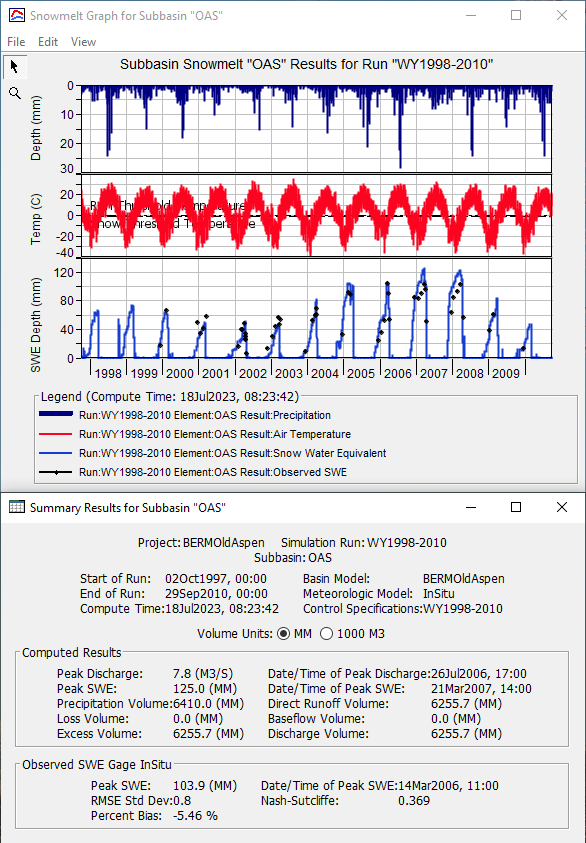
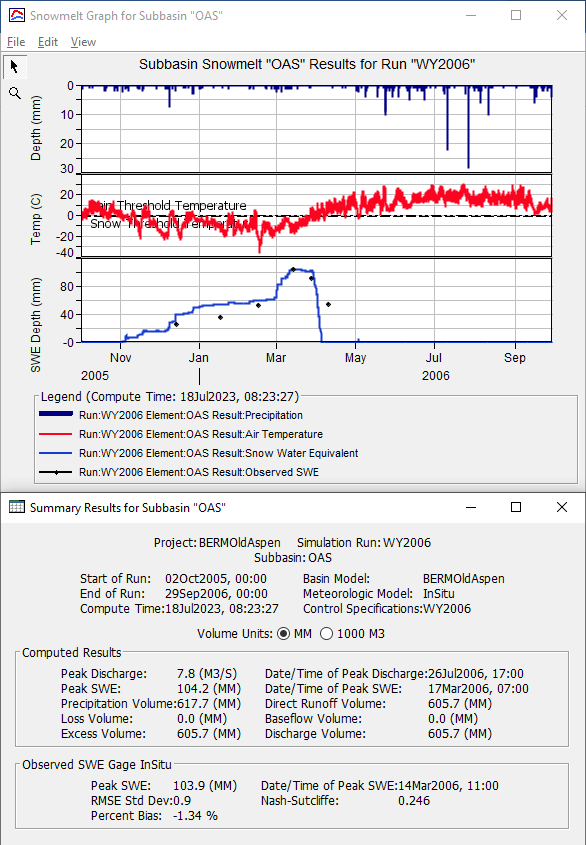
The total and maximum mass and energy balance errors for the WY2006 simulation are shown below:
| Parameter | Value |
|---|---|
| Sum Mass Balance Error (mm) | -1.1622 |
| Max Mass Balance Error (mm) | 0.0098 |
| Sum Energy Balance Error (W/m^2) | 3.6687E-9 |
| Max Energy Balance Error (W/m^2) | 2.6126E-11 |
The complete energy and mass balance verification for this location can be found here: OAS_Energy_and_Mass_Balance.xlsx. The completed HEC-HMS project for this location can be found here: BERMOldAspen.zip.
BERMS Old Black Spruce
The calibrated Energy Budget snow parameters for this location are shown here:
| Parameter | Value |
|---|---|
| Rain Threshold Temperature (deg C) | 1 |
| Snow Threshold Temperature (deg C) | -1 |
| New Snow Albedo | 0.85 |
| Min Snow Albedo | 0.1 |
| Albedo Refresh Depth (mm) | 3 |
| Albedo Decay Coefficient (hr) | 300 |
| Snow Thermal Conductivity (J/m/deg C/hr) | 400 |
| Liquid Water Retention Fraction | 0.05 |
| Snow Hydraulic Conductivity (m/s) | 0.005 |
| Soil Depth for Energy Balance (m) | 0.1 |
Two simulations were made for this location: 1) using the entire POR and 2) using only WY2002. The results of each simulation are shown below:
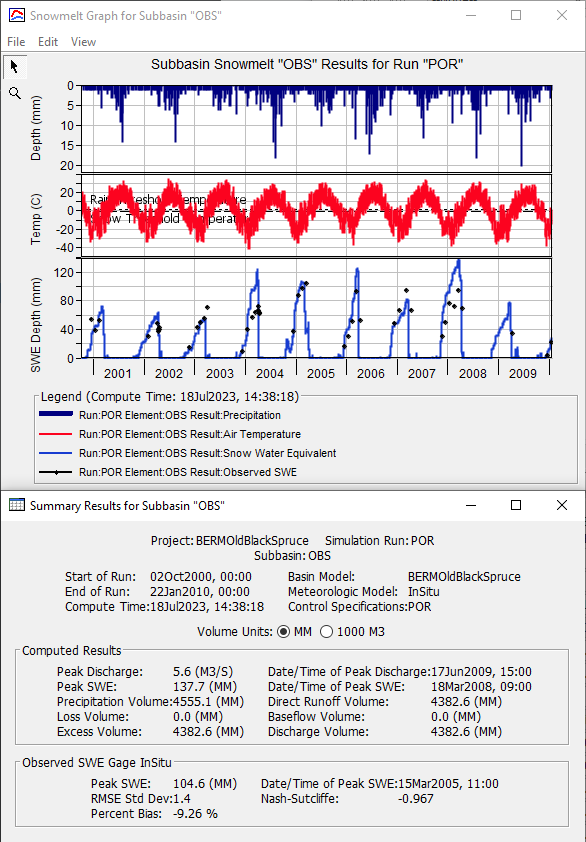
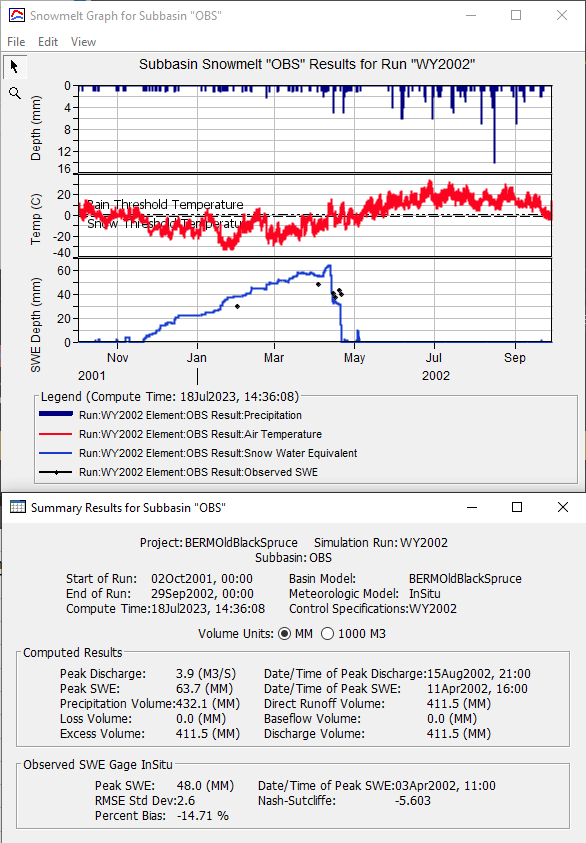
The total and maximum mass and energy balance errors for the WY2002 simulation are shown below:
| Parameter | Value |
|---|---|
| Sum Mass Balance Error (mm) | -1.6386 |
| Max Mass Balance Error (mm) | 0.0169 |
| Sum Energy Balance Error (W/m^2) | 8.8114E-9 |
| Max Energy Balance Error (W/m^2) | 2.6343E-11 |
The complete energy and mass balance verification for this location can be found here: OBS_Energy_and_Mass_Balance.xlsx. The completed HEC-HMS project for this location can be found here: BERMOldBlackSpruce.zip.
BERMS Old Jack Pine
The calibrated Energy Budget snow parameters for this location are shown here:
| Parameter | Value |
|---|---|
| Rain Threshold Temperature (deg C) | 0 |
| Snow Threshold Temperature (deg C) | 0 |
| New Snow Albedo | 0.85 |
| Min Snow Albedo | 0.1 |
| Albedo Refresh Depth (mm) | 3 |
| Albedo Decay Coefficient (hr) | 300 |
| Snow Thermal Conductivity (J/m/deg C/hr) | 400 |
| Liquid Water Retention Fraction | 0.05 |
| Snow Hydraulic Conductivity (m/s) | 0.005 |
| Soil Depth for Energy Balance (m) | 0.1 |
Two simulations were made for this location: 1) using the entire POR and 2) using only WY2007. The results of each simulation are shown below:
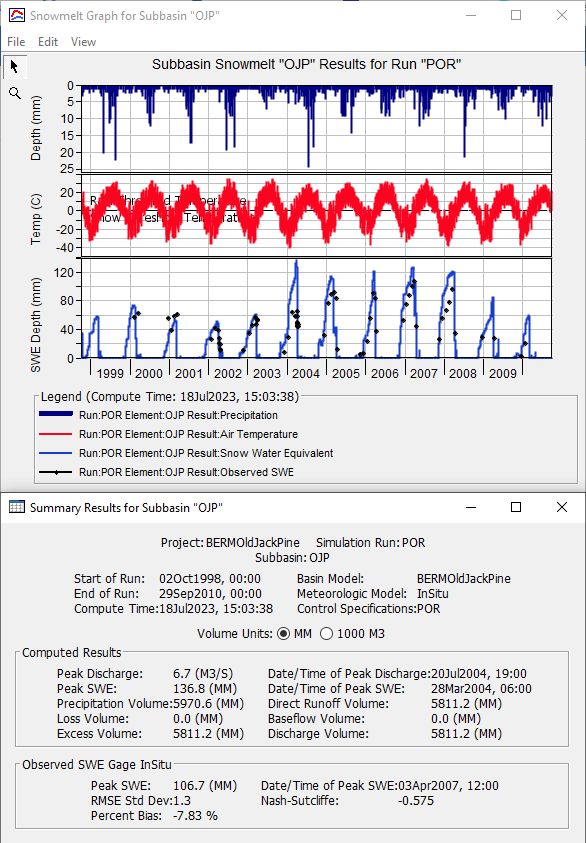
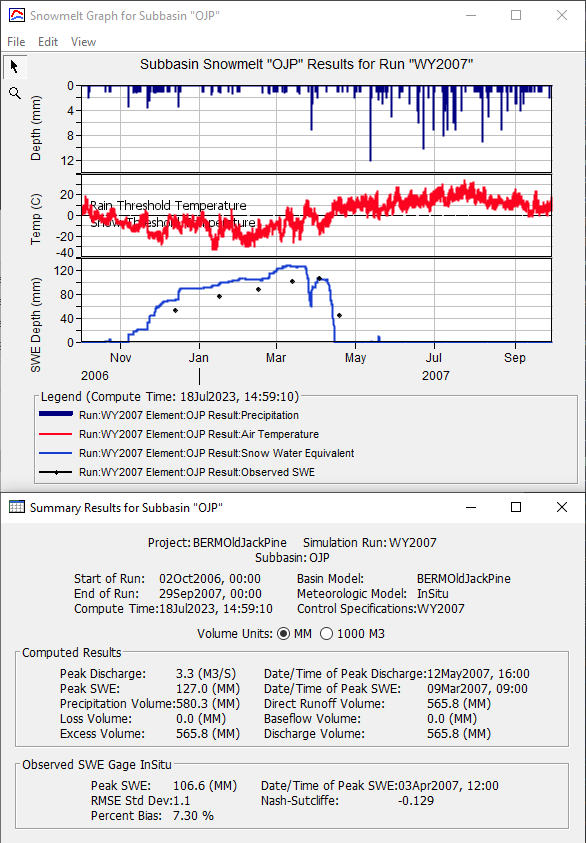
The total and maximum mass and energy balance errors for the WY2007 simulation are shown below:
| Parameter | Value |
|---|---|
| Sum Mass Balance Error (mm) | -1.0307 |
| Max Mass Balance Error (mm) | 0.0075 |
| Sum Energy Balance Error (W/m^2) | 1.5736E-8 |
| Max Energy Balance Error (W/m^2) | 2.7921E-11 |
The complete energy and mass balance verification for this location can be found here: OJP_Energy_and_Mass_Balance.xlsx. The completed HEC-HMS project for this location can be found here: BERMOldJackPine.zip.
Col De Porte
The calibrated Energy Budget snow parameters for this location are shown here:
| Parameter | Value |
|---|---|
| Rain Threshold Temperature (deg C) | 0 |
| Snow Threshold Temperature (deg C) | -2.75 |
| New Snow Albedo | 0.85 |
| Min Snow Albedo | 0.2 |
| Albedo Refresh Depth (mm) | 3 |
| Albedo Decay Coefficient (hr) | 575 |
| Snow Thermal Conductivity (J/m/deg C/hr) | 425 |
| Liquid Water Retention Fraction | 0.05 |
| Snow Hydraulic Conductivity (m/s) | 0.005 |
| Soil Depth for Energy Balance (m) | 0.1 |
Two simulations were made for this location: 1) using the entire POR and 2) using only WY2014. The results of each simulation are shown below:
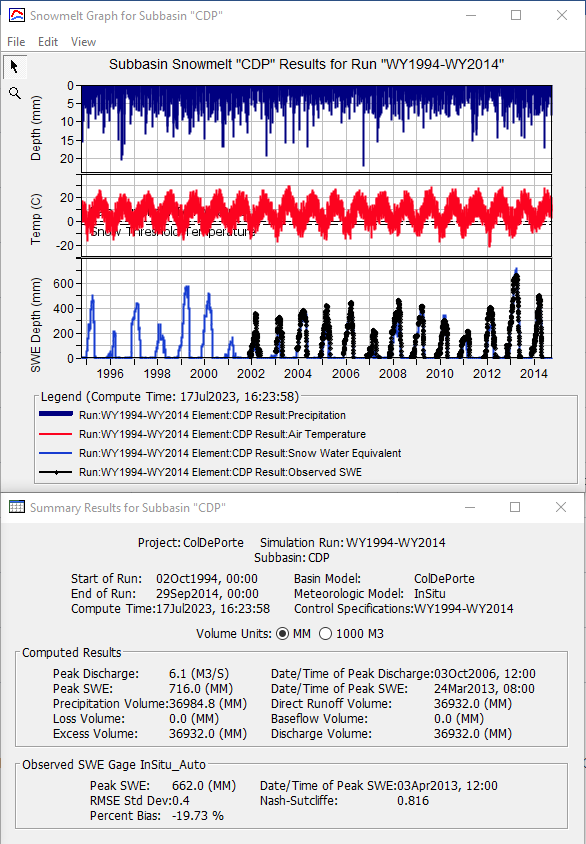
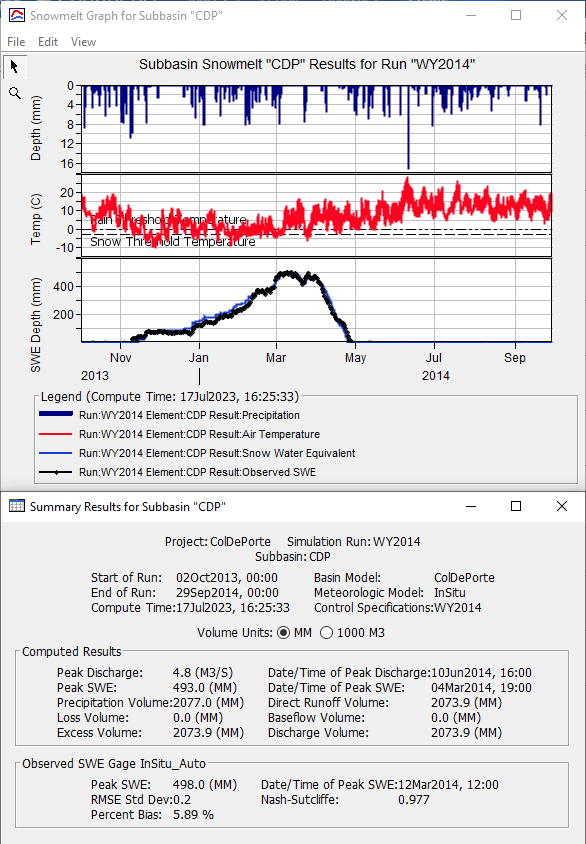
The total and maximum mass and energy balance errors for the WY2014 simulation are shown below:
| Parameter | Value |
|---|---|
| Sum Mass Balance Error (mm) | -1.6232 |
| Max Mass Balance Error (mm) | 0.021 |
| Sum Energy Balance Error (W/m^2) | 7.3251E-9 |
| Max Energy Balance Error (W/m^2) | 2.7640E-11 |
The complete energy and mass balance verification for this location can be found here: CDP_Energy_and_Mass_Balance.xlsx. The completed HEC-HMS project for this location can be found here: ColDePorte.zip.
Reynolds Mountain East
The calibrated Energy Budget snow parameters for this location are shown here:
| Parameter | Value |
|---|---|
| Rain Threshold Temperature (deg C) | 0 |
| Snow Threshold Temperature (deg C) | -1.5 |
| New Snow Albedo | 0.85 |
| Min Snow Albedo | 0.2 |
| Albedo Refresh Depth (mm) | 3 |
| Albedo Decay Coefficient (hr) | 350 |
| Snow Thermal Conductivity (J/m/deg C/hr) | 250 |
| Liquid Water Retention Fraction | 0.05 |
| Snow Hydraulic Conductivity (m/s) | 0.005 |
| Soil Depth for Energy Balance (m) | 0.1 |
Two simulations were made for this location: 1) using the entire POR and 2) using only WY2008. The results of each simulation are shown below:
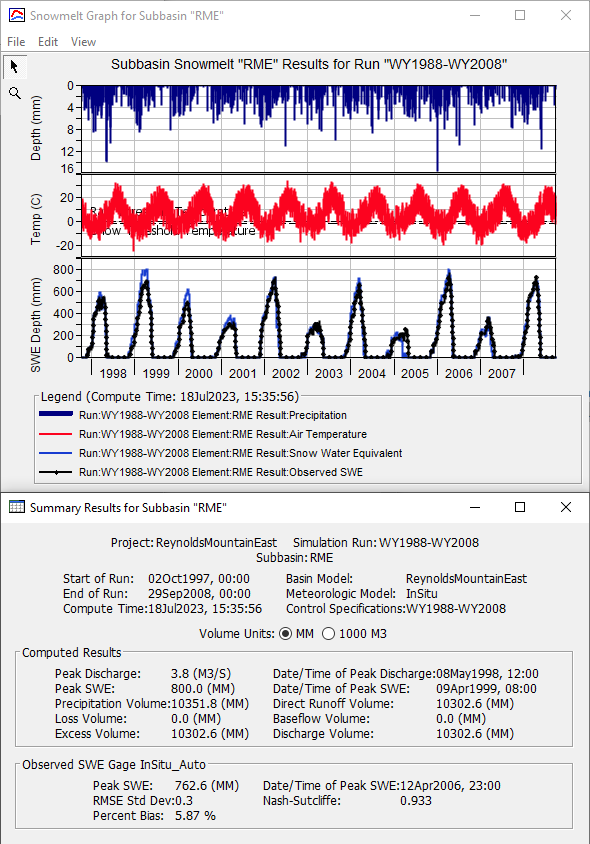
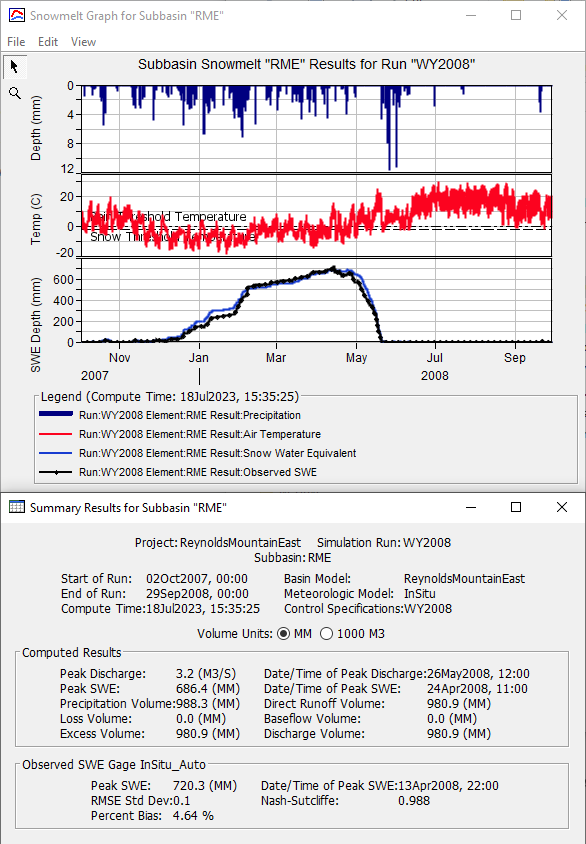
The total and maximum mass and energy balance errors for the WY2008 simulation are shown below:
| Parameter | Value |
|---|---|
| Sum Mass Balance Error (mm) | -2.4373 |
| Max Mass Balance Error (mm) | 0.0225 |
| Sum Energy Balance Error (W/m^2) | 1.6858E-9 |
| Max Energy Balance Error (W/m^2) | 2.7945E-11 |
The complete energy and mass balance verification for this location can be found here: RME_Energy_and_Mass_Balance.xlsx. The completed HEC-HMS project for this location can be found here: ReynoldsMountainEast.zip.
Sapporo
The calibrated Energy Budget snow parameters for this location are shown here:
| Parameter | Value |
|---|---|
| Rain Threshold Temperature (deg C) | 0 |
| Snow Threshold Temperature (deg C) | 0 |
| New Snow Albedo | 0.85 |
| Min Snow Albedo | 0.2 |
| Albedo Refresh Depth (mm) | 3 |
| Albedo Decay Coefficient (hr) | 150 |
| Snow Thermal Conductivity (J/m/deg C/hr) | 300 |
| Liquid Water Retention Fraction | 0.05 |
| Snow Hydraulic Conductivity (m/s) | 0.005 |
| Soil Depth for Energy Balance (m) | 0.1 |
Two simulations were made for this location: 1) using the entire POR and 2) using only WY2014. The results of each simulation are shown below:
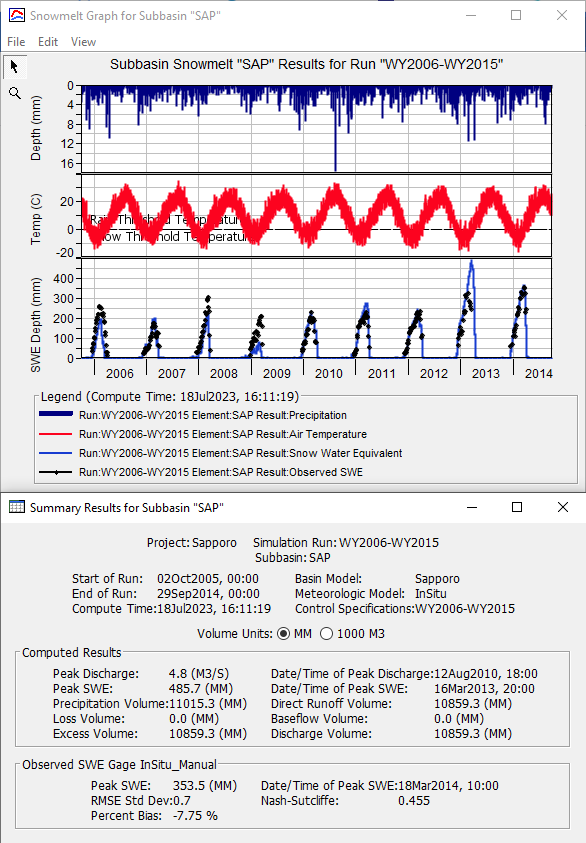
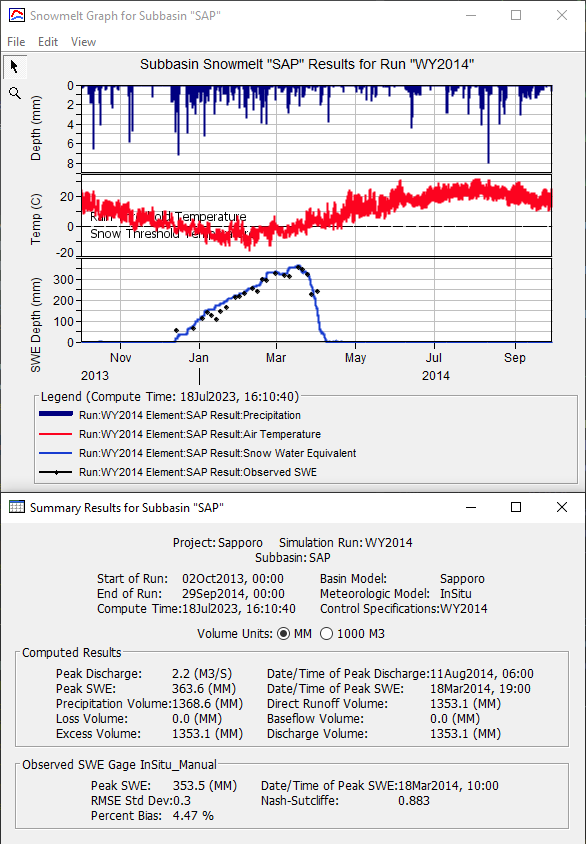
The total and maximum mass and energy balance errors for the WY2014 simulation are shown below:
| Parameter | Value |
|---|---|
| Sum Mass Balance Error (mm) | -1.1523 |
| Max Mass Balance Error (mm) | 0.0157 |
| Sum Energy Balance Error (W/m^2) | 2.6768E-9 |
| Max Energy Balance Error (W/m^2) | 2.4222E-11 |
The complete energy and mass balance verification for this location can be found here: SAP_Energy_and_Mass_Balance.xlsx. The completed HEC-HMS project for this location can be found here: Sapporo.zip.
Senator Beck
The calibrated Energy Budget snow parameters for this location are shown here:
| Parameter | Value |
|---|---|
| Rain Threshold Temperature (deg C) | 0 |
| Snow Threshold Temperature (deg C) | 0 |
| New Snow Albedo | 0.85 |
| Min Snow Albedo | 0.2 |
| Albedo Refresh Depth (mm) | 3 |
| Albedo Decay Coefficient (hr) | 150 |
| Snow Thermal Conductivity (J/m/deg C/hr) | 300 |
| Liquid Water Retention Fraction | 0.05 |
| Snow Hydraulic Conductivity (m/s) | 0.005 |
| Soil Depth for Energy Balance (m) | 0.1 |
Two simulations were made for this location: 1) using the entire POR and 2) using only WY2011. The results of each simulation are shown below:
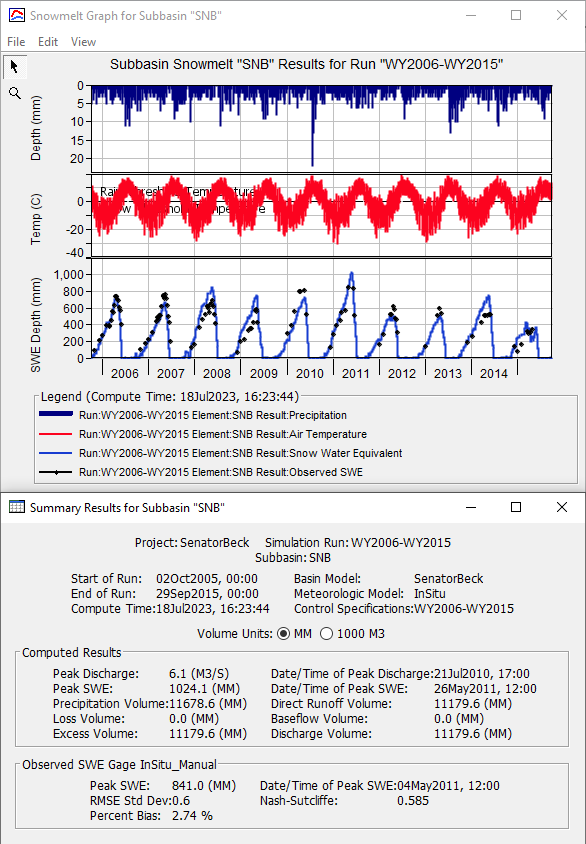
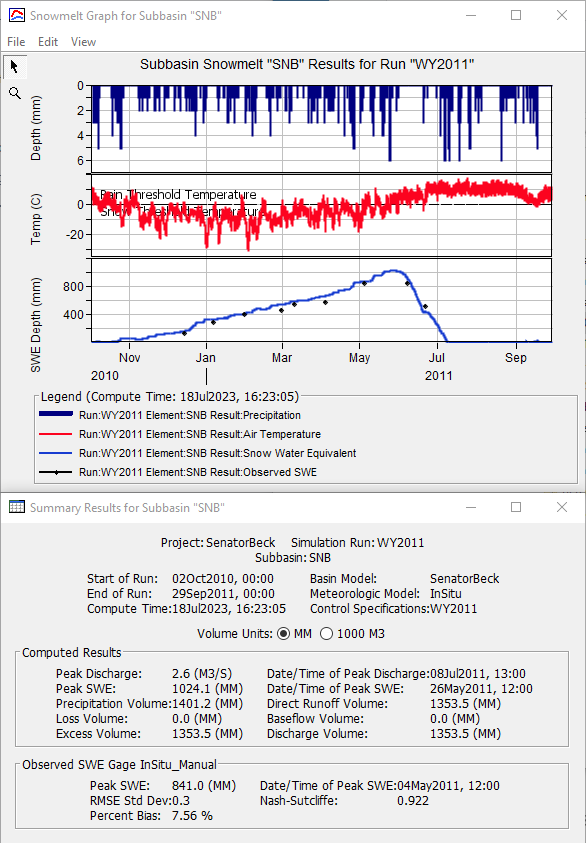
The total and maximum mass and energy balance errors for the WY2011 simulation are shown below:
| Parameter | Value |
|---|---|
| Sum Mass Balance Error (mm) | -8.7383 |
| Max Mass Balance Error (mm) | 0.0315 |
| Sum Energy Balance Error (W/m^2) | 3.6468E-8 |
| Max Energy Balance Error (W/m^2) | 2.7610E-11 |
The complete energy and mass balance verification for this location can be found here: SNB_Energy_and_Mass_Balance.xlsx. The completed HEC-HMS project for this location can be found here: SenatorBeck.zip.
Sodankylä
The calibrated Energy Budget snow parameters for this location are shown here:
| Parameter | Value |
|---|---|
| Rain Threshold Temperature (deg C) | 0 |
| Snow Threshold Temperature (deg C) | 0 |
| New Snow Albedo | 0.85 |
| Min Snow Albedo | 0.2 |
| Albedo Refresh Depth (mm) | 3 |
| Albedo Decay Coefficient (hr) | 400 |
| Snow Thermal Conductivity (J/m/deg C/hr) | 300 |
| Liquid Water Retention Fraction | 0.05 |
| Snow Hydraulic Conductivity (m/s) | 0.005 |
| Soil Depth for Energy Balance (m) | 0.1 |
Two simulations were made for this location: 1) using the entire POR and 2) using only WY2010. The results of each simulation are shown below:
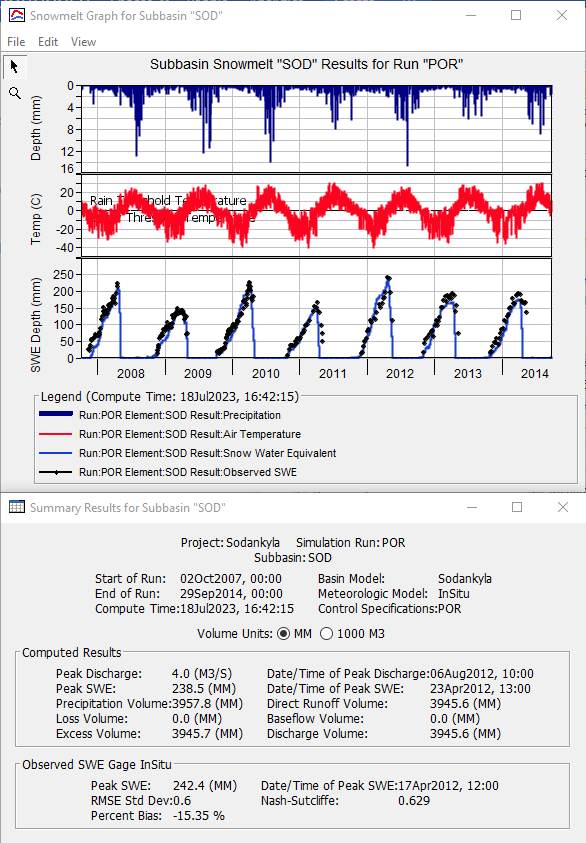
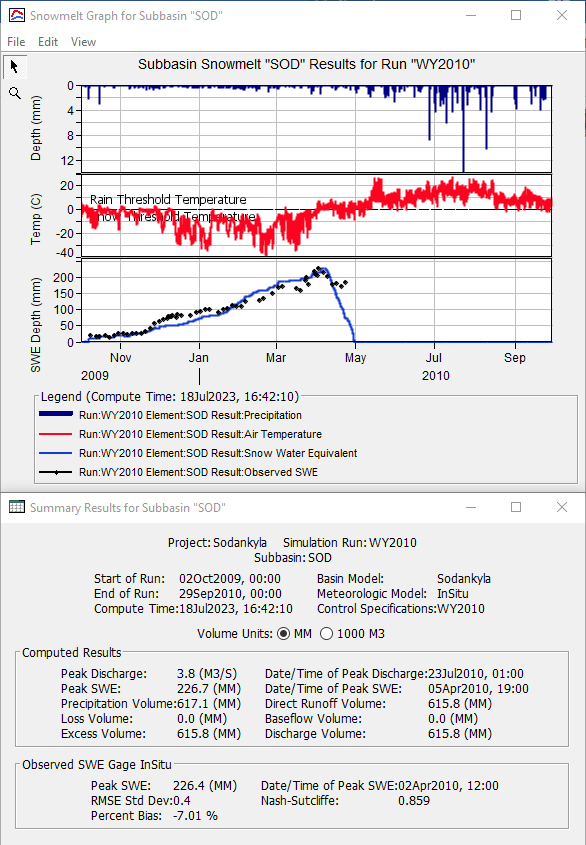
The total and maximum mass and energy balance errors for the WY2010 simulation are shown below:
| Parameter | Value |
|---|---|
| Sum Mass Balance Error (mm) | -1.3751 |
| Max Mass Balance Error (mm) | 0.0079 |
| Sum Energy Balance Error (W/m^2) | 1.3830E-8 |
| Max Energy Balance Error (W/m^2) | 2.7704E-11 |
The complete energy and mass balance verification for this location can be found here: SOD_Energy_and_Mass_Balance.xlsx. The completed HEC-HMS project for this location can be found here: Sodankyla.zip.
Swamp Angel
The calibrated Energy Budget snow parameters for this location are shown here:
| Parameter | Value |
|---|---|
| Rain Threshold Temperature (deg C) | 0 |
| Snow Threshold Temperature (deg C) | 0 |
| New Snow Albedo | 0.9 |
| Min Snow Albedo | 0.2 |
| Albedo Refresh Depth (mm) | 3 |
| Albedo Decay Coefficient (hr) | 300 |
| Snow Thermal Conductivity (J/m/deg C/hr) | 600 |
| Liquid Water Retention Fraction | 0.05 |
| Snow Hydraulic Conductivity (m/s) | 0.005 |
| Soil Depth for Energy Balance (m) | 0.1 |
Two simulations were made for this location: 1) using the entire POR and 2) using only WY2008. The results of each simulation are shown below:
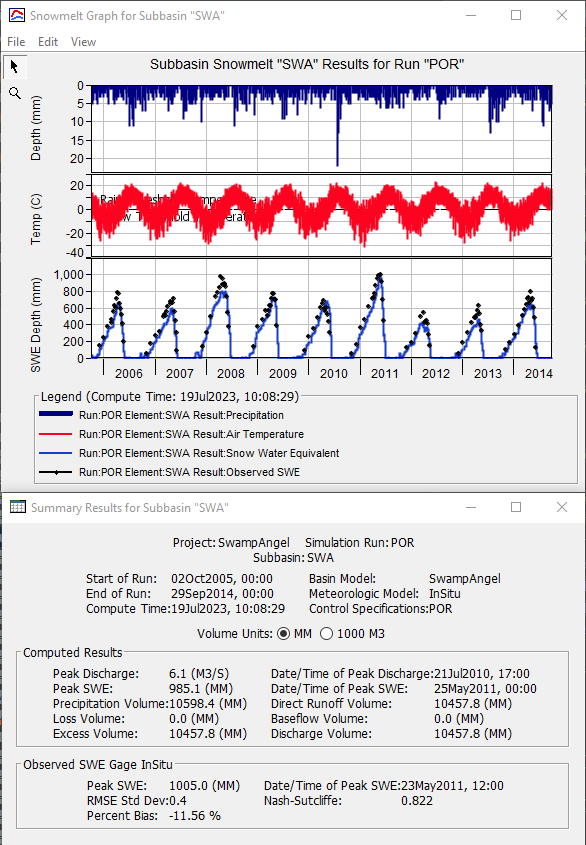
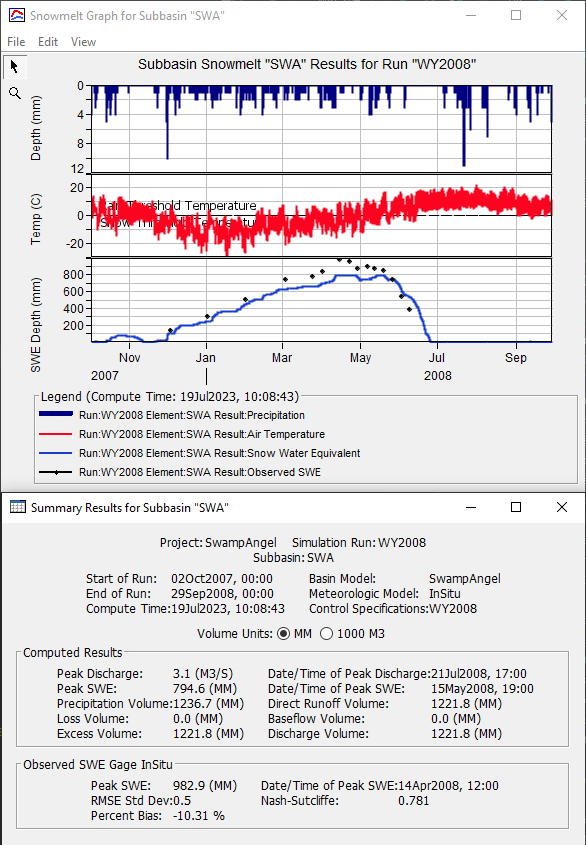
The total and maximum mass and energy balance errors for the WY2008 simulation are shown below:
| Parameter | Value |
|---|---|
| Sum Mass Balance Error (mm) | -0.8204 |
| Max Mass Balance Error (mm) | 0.0047 |
| Sum Energy Balance Error (W/m^2) | 3.7297E-8 |
| Max Energy Balance Error (W/m^2) | 2.7482E-11 |
The complete energy and mass balance verification for this location can be found here: SWA_Energy_and_Mass_Balance.xlsx. The completed HEC-HMS project for this location can be found here: SwampAngel.zip.
Weissfluhjoch
The calibrated Energy Budget snow parameters for this location are shown here:
| Parameter | Value |
|---|---|
| Rain Threshold Temperature (deg C) | 3 |
| Snow Threshold Temperature (deg C) | -1 |
| New Snow Albedo | 0.9 |
| Min Snow Albedo | 0.1 |
| Albedo Refresh Depth (mm) | 3 |
| Albedo Decay Coefficient (hr) | 350 |
| Snow Thermal Conductivity (J/m/deg C/hr) | 400 |
| Liquid Water Retention Fraction | 0.05 |
| Snow Hydraulic Conductivity (m/s) | 0.005 |
| Soil Depth for Energy Balance (m) | 0.1 |
Two simulations were made for this location: 1) using the entire POR and 2) using only WY2012. The results of each simulation are shown below:
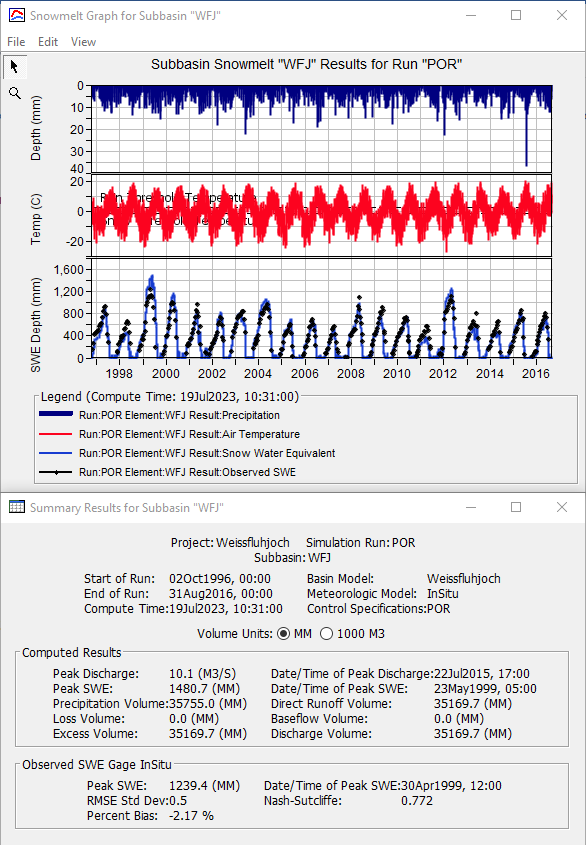
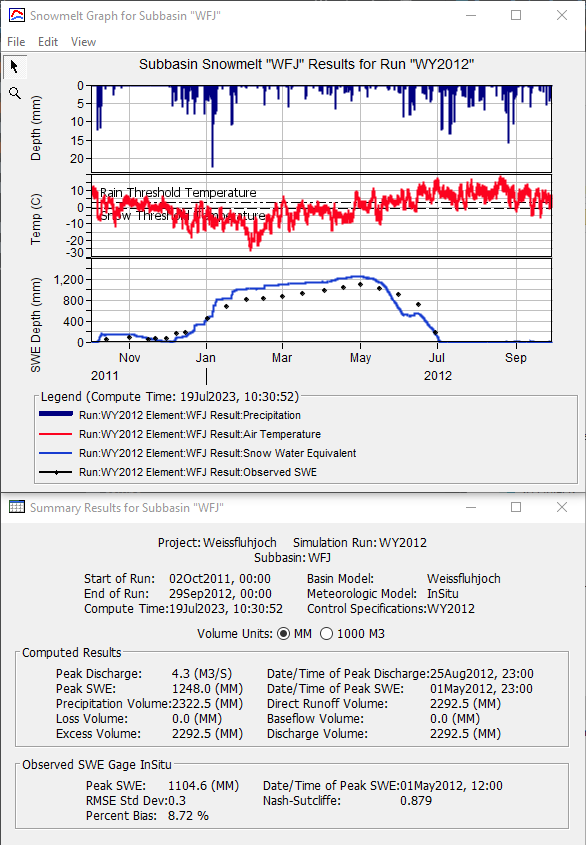
The total and maximum mass and energy balance errors for the WY2012 simulation are shown below:
| Parameter | Value |
|---|---|
| Sum Mass Balance Error (mm) | -6.3895 |
| Max Mass Balance Error (mm) | 0.0612 |
| Sum Energy Balance Error (W/m^2) | 3.0574E-8 |
| Max Energy Balance Error (W/m^2) | 2.7256E-11 |
The complete energy and mass balance verification for this location can be found here: WJF_Energy_and_Mass_Balance.xlsx. The completed HEC-HMS project for this location can be found here: Weissfluhjoch.zip.
Summary
The Energy Budget snow method within HEC-HMS was successfully validated and verified using the ten ESM-SnowMIP locations (Menard et al, 2019). Individual HEC-HMS projects were constructed for each of the ten locations and model parameters were calibrated using observed data to ensure that reasonable results were produced. Following model calibration, the energy and mass balances were calculated to verify that the computations were producing appropriate results.